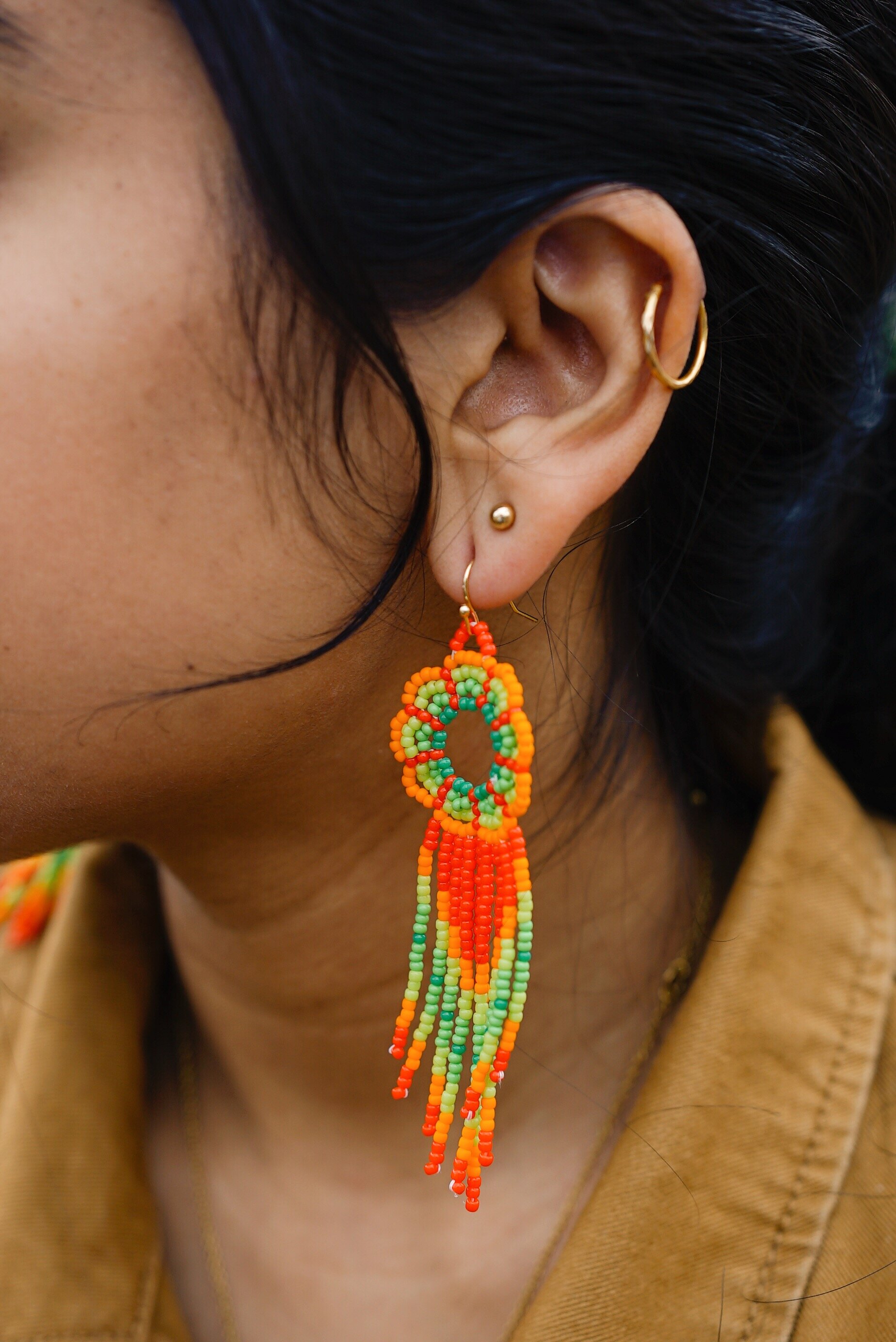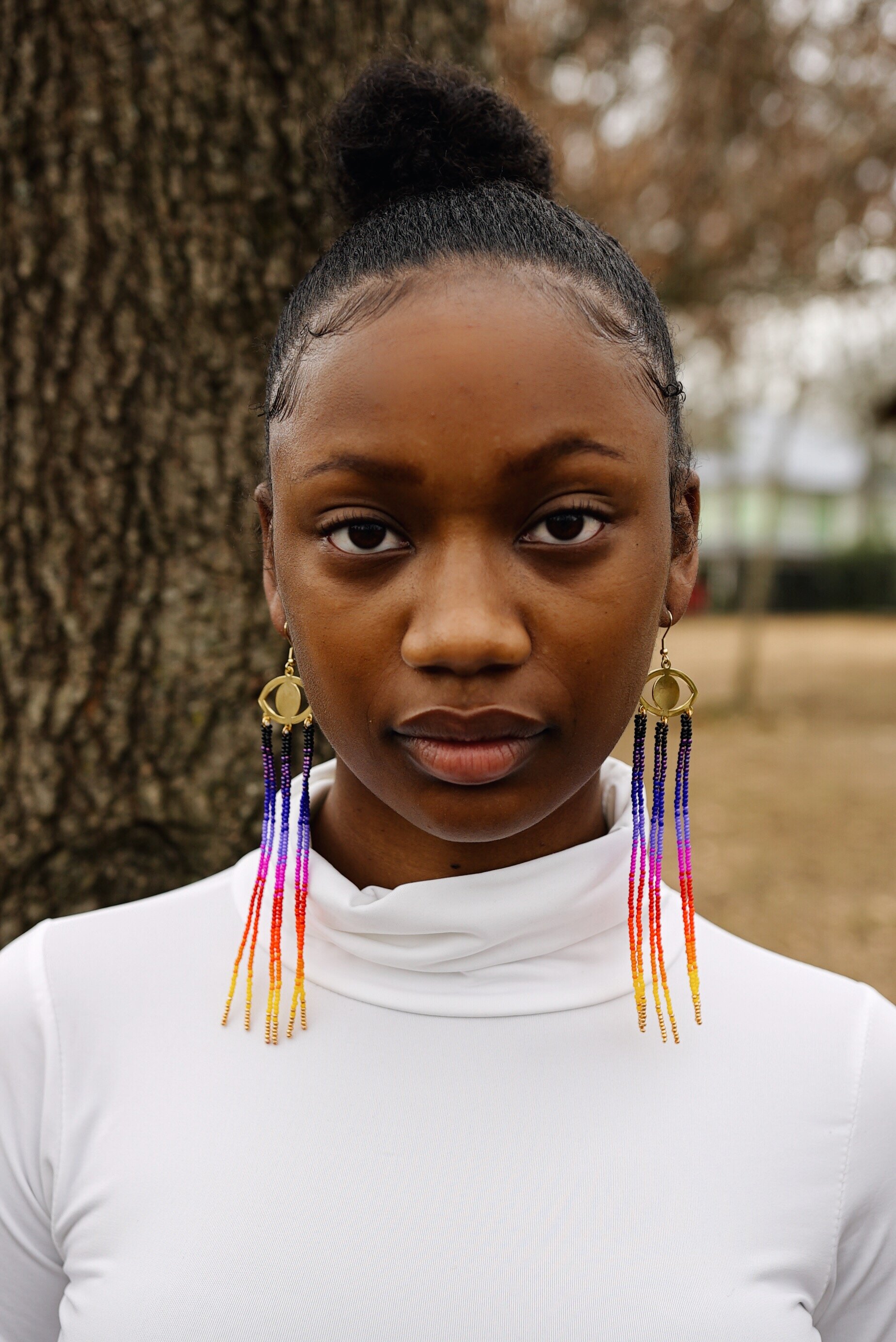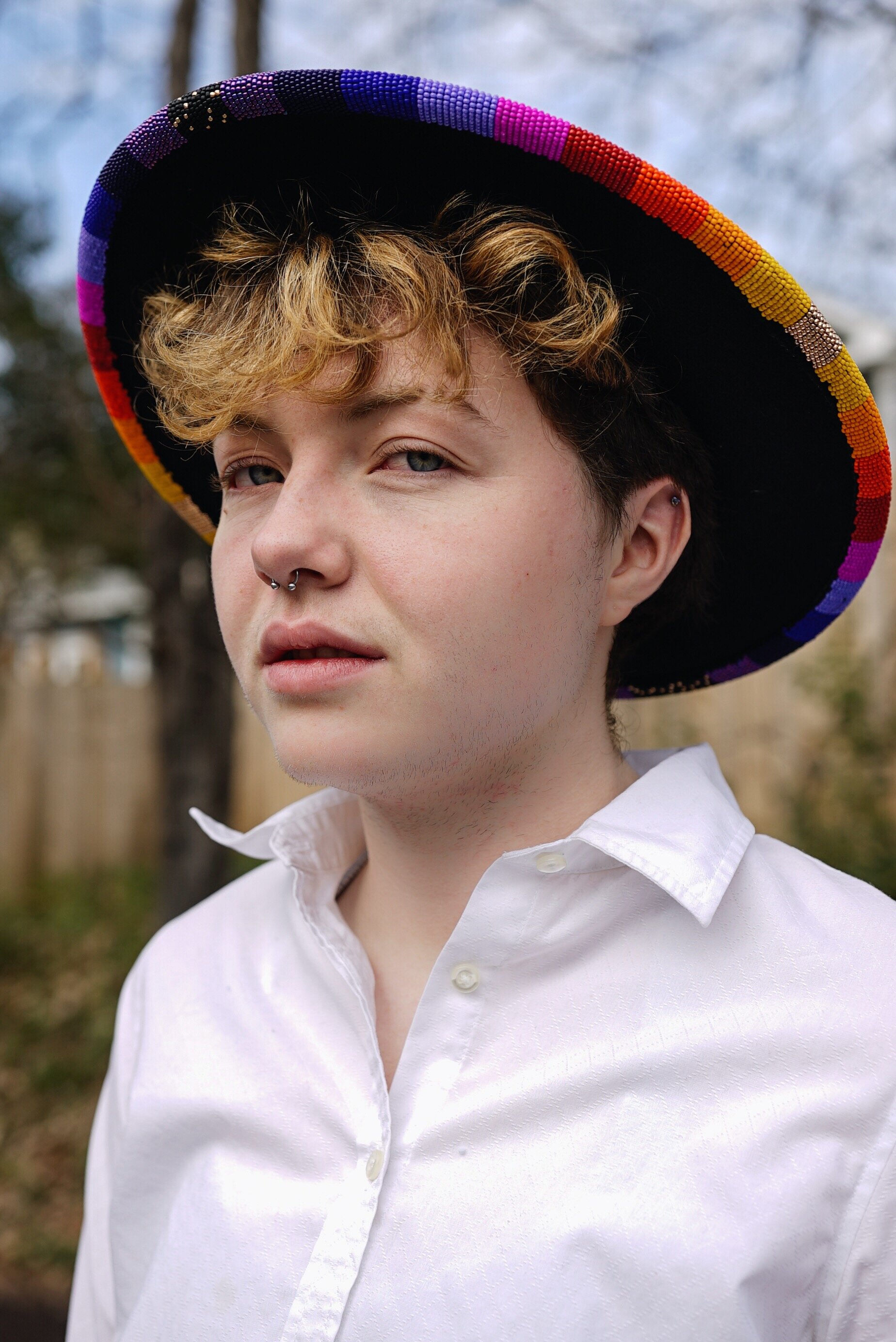Artist Series: Huichola Made

Katy Gräble Gonzalez is a mixed-race Indigenous artist, specifically of the Huichol / Wixárika people, currently residing in Durham, North Carolina. She uses her Instagram and website platform Huichola Made as a space to sell her art as well as educate on social and cultural topics.
Mindy Wu: Can you tell me a bit about yourself and your background?
Katy Gonzalez: I grew up in a military family and moved around a lot. I was born in Hawaii, and my parents are both from California. I spent most of my childhood in Germany and moved to Texas when I was 16. I was in Texas for about the last half of high school, through college and grad school, and then I started my professional career there. Then, my partner got a job here in Durham, and we relocated from Texas to Durham in late 2018.
MW: Where was your favorite place to live?
KG: I really enjoyed growing up in Germany. It's super different from the states, especially the German school system. I think the biggest part for me was the fact that it's so accessible to travel when you live in Europe. My family got to do a lot of traveling and had a lot of privilege in that kind of accessibility, to just be able to drive a few hours and be in another country. That's an opportunity that is not afforded to a lot of other people, especially other BIPOC. I know that my parents could have never afforded to show me the world as a child and traveled with me, but because I grew up in Europe, it was so much easier for me to experience the world. So I'm really thankful for that.
MW: Who would you say are your artistic influences?
KG: It's really the beading style and cultural style of arts that are more traditional to my people and different parts of my cultures. A lot of the designs that I make are traditional Wixárika designs. If you visit Mexico, it's obvious that it's a trademark of our culture. I blend a lot of colors that are commonly used in Mexican folk art, which is known to be super colorful and really beautiful. I like learning to incorporate different influences and motifs from different cultures of mine, and finding unique ways to blend those cultures together.
MW: Do you have an example of one of your pieces with a blend of cultural influences?
KG: It's this symbol on the Philippines flag — this really beautiful sun. It's used on a lot of iconic Filipino art and imagery. I made a pair of earrings with that on them for my mom. Little things like that. And blending in colors that remind me of people and places. And more recently, doing more print work that blends those together.
MW: When you describe the artistic themes of your pieces to be more cultural, are there other sorts of messages that you try to convey with your pieces?
KG: It's deeply cultural and personal. Especially because my grandfather was a beader. When I was a kid, he used to make me necklaces, bracelets, and earrings. I would sit in the backyard with him while he made things for me, and he would teach me how to bead as well. That's one of the last remaining things I really have of him. And when my family moved to the United States, like a lot of immigrant families, they assimilated and lost a lot of themselves. They really took the “white is right'' mentality and ran with it, and gave up a lot of things that made them who they are, things that made them special. I feel like there's a level to that when families come to America, but for Indigenous families, it's also like they give up a part of themselves to assimilate with like Mexican identity. So there are two layers to it. My Indigenous family really assimilated with Mexicanhood. And when they came to the United States, they really assimilated with American identity. Beading is one of the last remaining pieces that I grew up with and was familiar with, but didn't really realize that this isn't like a pan-Mexican thing. This is not Mexican culture. This is Wixárika culture. This is Huichol culture. And this is something that's really foundational to who we are. And going on this journey of reclaiming indigeneity and relearning that part of my blood — beading was a deeply personal way for me to connect.
MW: You mentioned that your grandfather used to bead jewelry for you. How did you learn to bead, and are there any certain tools or materials that are unique to your process?
KG: I remember little bits and pieces of how to bead. One thing in particular that he used to make for me were these daisy chains with beads, which is something I make still. Starting out, I bought some beads, and I tried to see if I could remake it and remember the steps to it. I followed a few beaders on Instagram who were Indigenous-Mexican, or Mexican identity, and was always so inspired and in awe of their creativity and craft. That, along with the desire to reconnect, made me want to learn more. I actually ended up finding tutorials on YouTube, and I was sad to see that most of them were super problematic. A lot of the tutorials on YouTube are white women appropriating different motifs of beads that are culturally significant to Indigenous peoples, and it made me kind of sad that that was the only accessible way for me to learn. A goal that I have is to provide some kind of instruction that's accessible for Indigenous people who want to learn how to bead so that they don't have to learn from culture vultures online, because that's not something I really see offered. It would be lovely to be able to be an auntie, a good elder, or a good future elder and provide these resources for people.
MW: Could you talk about the background of Huichola Made and how this Instagram started?
KG: I started beading again in October 2019. I bought supplies from a bead store in Carrboro, and I sat down one weekend and was like, “I'm gonna figure this out, I'm going to learn.” I didn't do it every day; I would do it in spurts. I would make pairs for people or I'd make pairs for myself. Then I traveled a lot and spent six weeks on a research expedition in Antarctica at the beginning of 2020, so I took a long break from it. When I got home from this research expedition, I basically had two weeks of freedom before the pandemic started to restructure our lives the way we knew it. One day — I don't really remember why — I started the Instagram to share the journey and how culturally significant it is to reclaim something like this through art. I think the page’s anniversary is in the next few weeks. At first it was really just my close friends that followed me, and then it expanded a bit more to a wider but still small community of Native women. I did irregular batch sales. And then in August, I had this post go viral, and I gained followers. It's been like a wild ride.
MW: Social media has been a really interesting aspect of being an artist in the past couple of years. How do you see the place of it fitting into what an artist does?
KG: I just got a promotion, but I was a social media manager. Now I'm doing more things under the digital umbrella in addition to social media management, so I have worked in social media for most of my career. It's really interesting to be someone who uses social media for an NGO versus for my own art and for my own platforms. There's something about what social media offers to artists in terms of community building, as well as supporter and movement building. I never really expected to have a digital education platform like I do now. I never really expected it to be half education, half e-commerce — almost like a small business. I think it's really cool how artists can build platforms and do their own marketing and promotion through their social media channels, and it offers them a way to do so authentically on a daily basis. And I honestly just love following artists because of that, and I love being able to have an Instagram and have social media presence in that way, because I feel like it's just such an authentic way to connect and share people's crafts with each other and like, learn about their crafts and their cultures in one place. I love the role of social media in movement spaces, but also in artist spaces as well.
MW: What's your favorite and least favorite part about having this business?
KG: I enjoy making people feel seen and validated and loved in some kind of way with the platform that I have and the things that I speak on, especially being a mixed race person. I think it was last week I had someone who left this problematic comment, and I've had a few people who don't like the fact that I'm a mixed-race Indigenous person taking up space, because I'm not “real” or “enough”— like I'm not anything enough for them. I took that opportunity to speak on how mixed-race people feel in their ability to take up space and people's willingness or unwillingness to let them take up space in their communities. I was overwhelmed by how many messages I got from people who were like, “I've never had anybody speak on this like this, and I feel really seen, because people identity-police me all the time.” It's really easy to get into the kind of colonialism ideal of not being enough, and I just really enjoy having conversations like this with people and posting about it.
And along those lines of having people feel seen with my work is I make a lot of pride pieces. I make a lot of bi-pride flag earrings, rainbow earrings, trans pride flag earrings, and it's always really special to me to know that people who are wearing these feel affirmed and beautiful and proud in different ways. Even for some people, like people who may not be out, maybe wearing a pride flag earring is the only way they feel comfortable being themselves out in public because they're not ready to say it loud and proud yet. There are multiple ways of affirming and showing people that they're beautiful and worthy of feeling seen.
MW: How do you come up with each idea or vision for your pieces? And once you get that vision, how do you make it come to life?
KG: A lot of the time I might see colors somewhere. I have a friend who makes these beautiful macrame wall hangings. Sometimes I see the colors that she uses in the designs she makes, and it inspires me to make things in the same vein. She's like a magician with the palettes. It's amazing. I'm just enamored with colors — I always have been. I've always been really particular about colors, and I often experience synesthesia as well. If I'm laying in bed listening to music, I see colors associated with things. A lot of the time I think about the colors of things that I'm listening to or watching while I'm beading, and I remember every book, every audio book I was listening to while I was making earrings. If I was listening to music, I remember what songs or what album it was or what playlist. I was listening to a book series a while back last year, and I was beading with a lot of blacks and purples and rich gemstones because that's how I associated the colors of the books with the beads I was using.
MW: Do you have a favorite earring or piece that you've made so far?
KG: I really love the eclipse earrings that I make where it's half-sun, half-moon. That's another cultural design that's special to me, because that's something that a lot of Wixárika beaders make. It's very difficult and time-consuming, but it's so beautiful and so intricate. And that's why I keep revisiting those as well.
MW: As a final question, is there any advice you would give to like a young budding artist?
KG: I wish someone told me not to give into the temptation of comparison. I feel like for artists, it's easy for us to fall into this trap of comparing our work to others’. When I started beading, I was comparing myself to beaders who had been making for years. Why can't my work look like this? That's an issue because you can't expect to be an expert. You can't expect to make flawless work from day one. You need to hone your craft and figure out what works for you. I have to realize that what we're doing is two totally separate things; my style is so different from their style, and that's totally fine. I want it to be different because I'm a different person, and I'm influenced by different things influenced by different cultures. For so many reasons, it's critical to stand firm in how we are culturally informed and how we're making art.
Interview and photos by mindy wu
special thanks to katy Gräble Gonzalez
Website: https://www.huicholamade.com/
Instagram: @huicholamade










